Understanding the Earth Box: A Sustainable Gardening Solution
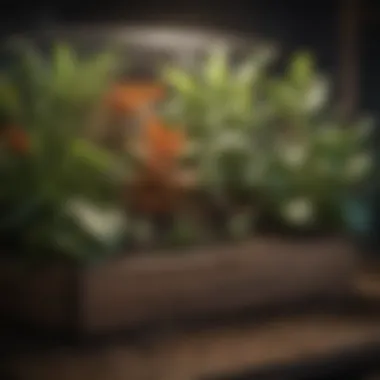

Intro
Gardening in urban spaces has become increasingly important as cities continue to expand and populations grow. Limited outdoor space and soil quality often pose challenges for urban dwellers who wish to cultivate their own plants. One solution to these challenges is the Earth Box system, a concept that marries sustainability with functionality. This article delves into the Earth Box, offering a detailed look at its features, benefits, and practical uses for various plant types. By examining the best practices associated with this method, we aim to inform and empower those interested in enhancing their gardening efforts in a time when such endeavors are more vital than ever.
Topic Overview
Definition and Importance
The Earth Box is a self-watering gardening system designed for efficient, sustainable plant growth in confined areas. It enables individuals to cultivate a variety of plants, providing benefits such as increased yield and reduced water consumption. This system is particularly relevant in urban gardening as it promotes food security and environmental responsibility. The design of the box supports optimal growing conditions by conserving moisture and nutrients, allowing for successful crop production even in less than ideal environments.
Brief History and Evolution
The Earth Box was developed in the 1990s, aimed at simplifying the gardening process while maximizing efficiency. It gained traction among gardeners who sought methods to improve yields in limited spaces. Over time, it has transformed from a niche product into a mainstream solution for urban farmers, educational programs, and communities advocating for sustainable agriculture. The evolution of this system reflects a growing awareness of the importance of local food production and sustainable practices.
Key Techniques and Innovations
Sustainable Farming Practices
The Earth Box embraces several sustainable practices that contribute to its efficiency. Among these practices are drip irrigation, soil conditioning, and the use of organic nutrients. By implementing such methods, gardeners minimize waste and environmental impact. The self-watering feature of the Earth Box is particularly noteworthy, reducing the frequency of watering and ensuring that plants receive consistent moisture without excess runoff.
Advanced Agronomic Technologies
Recent advancements have introduced innovative materials and technologies to enhance the Earth Box design. For example, the use of recycled plastic in the construction of these boxes supports sustainability efforts. Additionally, the integration of sensors and soil moisture meters can inform gardeners on the optimal time to water, further improving plant health and resource efficiency.
Practical Applications
Step-by-Step Guides
- Choosing the Right Box: Select an Earth Box suitable for your space and plant types.
- Setting Up: Prepare the box with a layer of charcoal at the bottom, then fill it with high-quality soil.
- Plant Selection: Opt for plants that thrive in contained environments, such as tomatoes, peppers, or herbs.
- Watering System: Connect the water fill tube and monitor water levels regularly.
- Maintenance: Regularly check for pests and add nutrients as necessary to support plant health.
Case Studies or Real-World Examples
Numerous community gardens and schools have adopted the Earth Box system to facilitate gardening education and local food production. For instance, many urban schools have implemented Earth Boxes to teach students about plant biology and sustainable practices while providing fresh produce. Such initiatives demonstrate the versatility and effectiveness of the Earth Box, showcasing its role in fostering community engagement and promoting healthy lifestyles.
"The Earth Box is not just a gardening tool; it is a gateway to sustainable urban agriculture, proving that anyone can cultivate their own food regardless of space limitations."
What is an Earth Box?
The Earth Box represents a significant advance in urban gardening methods. It allows people with limited space to grow vegetables, herbs, and flowers effectively. This section provides a deeper understanding of the Earth Box, its origins, and its fundamental principles. By grasping these concepts, gardeners can better utilize this innovative system to enhance their cultivation efforts in space-constrained environments.
Definition and Origin
An Earth Box is a self-watering container gardening system designed to maximize plant growth within a compact space. The concept originated in the 1990s when a need arose for urban dwellers to cultivate their own food despite having limited area for gardening. The system uses innovative technology, encouraging efficient water and nutrient management. Its design allows for optimal planting conditions, making it accessible for both novice and seasoned gardeners.
Basic Principles
The Earth Box operates on several core principles that distinguish it from traditional gardening methods. First, it utilizes a self-watering mechanism. This system operates by drawing water up from a reservoir located below the soil level, supplying the plants consistently. Not only does this reduce water waste, but it also ensures plants receive adequate moisture throughout their growing cycle.
Second, the Earth Box focuses on soil and nutrient management. It employs a mixture of components tailored for ideal drainage and aeration, which promotes healthy root growth. Applied nutrients are gradually released over time, minimizing the need for frequent fertilization.
In summary, understanding what an Earth Box is, including its definition and the underlying principles, is essential for anyone looking to optimize their gardening practices. The combination of these features makes the Earth Box a suitable solution for sustainable and efficient gardening in urban settings.
Features of the Earth Box
The Earth Box stands out due to its unique features that contribute to effective gardening in compact spaces. These characteristics not only enhance the gardening experience but also foster sustainable practices. Understanding these features is key to unlocking the potential of the Earth Box and maximizing its benefits for urban gardening.
Self-Watering System
One of the most significant elements of the Earth Box is its self-watering system. This feature is designed to ensure that plants receive consistent moisture without overwatering. It functions through a simple yet efficient design that allows water to be stored in the reservoir at the bottom. This reservoir is topped with a wicking system that draws water up into the soil when needed. The self-watering mechanism is particularly beneficial in preventing root rot, common in traditional gardening methods when frequent watering occurs.
Because of this system, users can enjoy less frequent watering sessions. This appeals to both busy gardeners and those with physical limitations. It’s essential to monitor the water level, but overall, this feature simplifies the maintenance of the plants.
Soil and Nutrient Management
Soil and nutrient management also play important roles in the success of using an Earth Box. Unlike typical garden setups, the Earth Box employs a carefully calibrated mix of soil and organic fertilizers. This mixture is specifically formulated to facilitate optimal nutrition for plants. As plants grow, they deplete nutrients in the soil. However, the Earth Box allows easy replenishment of these nutrients through the top soil fill methods.
Utilizing a combination of slow-release fertilizers and organic matter, gardeners can ensure that their plants receive the essential nutrients throughout their growth stages. This minimizes the risk of nutrient deficiencies, leading to healthier plants and better yields.
Compact Design
The compact design of the Earth Box is another notable feature. Its rectangular shape and elevated structure make it an ideal choice for anyone with limited space. This design allows the box to fit into small yards, balconies, or patios, making gardening accessible even in urbanized areas.
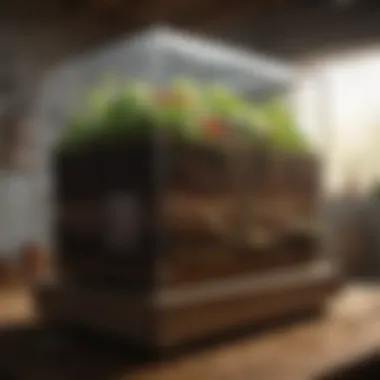
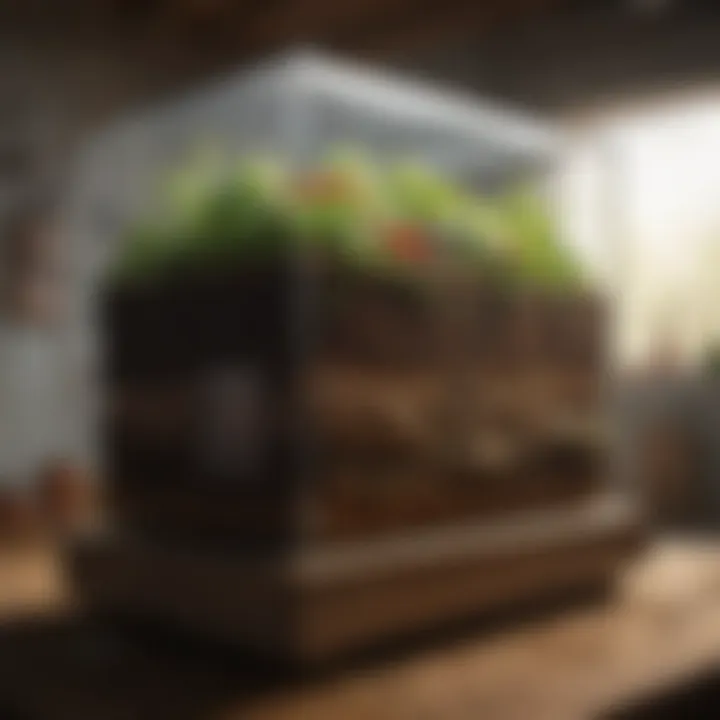
Additionally, the Earth Box is vertically oriented, providing ample surface area for planting while maintaining a small footprint. This not only beautifies spaces but also maximizes productivity by enabling a diverse range of plants to grow together. The versatility of this compact design means that you can easily rearrange the boxes for optimal sunlight exposure or aesthetic purposes.
In summary, the features of the Earth Box—its self-watering system, efficient soil and nutrient management, and compact design—contribute significantly to urban gardening. By utilizing these attributes, gardeners can achieve successful growth with minimal effort, making the Earth Box an invaluable asset in sustainable agricultural practices.
Benefits of Using an Earth Box
The Earth Box offers distinct advantages that can significantly enhance the gardening experience, especially in compact urban environments. This section dissects the primary benefits of using an Earth Box, illustrating how it optimizes the approach to urban gardening and contributes to sustainable practices.
Water Conservation
One of the most salient benefits of the Earth Box system is its remarkable capacity for water conservation. The design incorporates a self-watering mechanism that minimizes evaporation and runoff. This feature is crucial, particularly in regions where water resources are limited.
The reservoir at the bottom holds water, which is absorbed through a wick system that delivers moisture directly to the roots. This method ensures consistent hydration without overwatering, which often leads to root rot and other issues. By being able to retain water efficiently, the Earth Box promotes responsible water usage.
"Water conservation is not just a practice; it is a necessity in today’s gardening."
Optimal Growth Conditions
The Earth Box creates an environment that promotes optimal growth for various plants. The combination of its self-watering capability and its unique soil mix allows for better nutrient retention and aeration. This aeration is vital for root development, ensuring that plants can access oxygen and essential nutrients.
Additionally, the height of the Earth Box reduces the likelihood of pest invasions, providing a natural defense for seedlings and established plants alike. The positioning allows gardeners to control light exposure, which can be crucial in maximizing plant health.
By maintaining an ideal soil moisture level and improving root conditions, gardeners can expect better yields, making the Earth Box a favorable option for both novice and experienced cultivators.
Versatility for Various Crops
The Earth Box's versatility is another of its key advantages, allowing it to support a broad spectrum of crops. Whether someone is interested in growing vegetables, herbs, or flowers, the adjustable planting options cater to diverse gardening requirements.
For instance, tomatoes, peppers, basil, and marigolds can all thrive in an Earth Box. This adaptability makes it an excellent choice for people keen on experimenting with different plant types or those seeking to cultivate a balanced garden.
In summary, the Earth Box not only optimizes resource use but also tailors growth conditions to meet the specific needs of a wide range of plants. By employing this container gardening system, users can enjoy a fruitful and sustainable gardening experience.
Setting Up Your Earth Box
Setting up your Earth Box is a critical step that determines your success in gardening. This phase involves understanding how to create an efficient growing environment for your plants. Each aspect of the setup is designed to maximize productivity while minimizing the effort needed to maintain your garden. The Earth Box system is particularly useful in urban settings, where space is limited. By following the right procedures, you can create an optimal ecosystem that enhances plant growth.
Required Materials
To effectively set up your Earth Box, you will need several materials. These items are essential for creating a functional planting environment:
- Earth Box Container: This is the primary component of the system.
- Support Stakes: Needed for climbing plants or to provide stability.
- Planting Mix: A specialized soil mixture designed for self-watering systems.
- Fertilizer: Balanced nutrients to support plant growth. Organic options are preferable.
- Seedlings or Seeds: Choose plants that are suitable for container gardening.
These materials can usually be found at garden centers or online gardening retailers. Ensuring you have the right tools and materials at the beginning saves time and ensures you are prepared for the planting stage.
Assembly Instructions
The assembly of the Earth Box is straightforward. Here are the simplified steps you should follow:
- Prepare the Earth Box: Clean the container if you've used it before. Ensure that no previous materials or chemicals are affecting the new setup.
- Insert the Water Reservoir: Place the water reservoir component at the bottom of the Earth Box. This will help in maintaining moisture levels without overwatering.
- Add the Overflow Drain: This feature prevents water from pooling, which can lead to root rot. Ensure it is positioned correctly.
- Fill with Planting Mix: Carefully add the soil mixture to the container, leaving some space at the top for planting. Follow any specific instructions provided with the planting mix.
- Insert Support Stakes: If you're growing trellising plants, insert the stakes at this stage, ensuring they are deeply secured.
- Plant Your Seeds or Seedlings: Now you can introduce your plants. Make sure to follow the spacing requirements for the type of plant you are using.
Following these instructions closely ensures a functional and effective Earth Box setup. Incorrect assembly might lead to poor water management and reduced crop yield.
Soil Preparation
Soil preparation is a crucial aspect of setting up your Earth Box. The right soil serves as the foundation for your plants' health. Here are the key points to consider:
- Choosing the Right Mix: Utilise a quality soil mix formulated for container gardening. This mix should provide excellent drainage while retaining moisture.
- Nutrient Balance: Incorporate a slow-releasing fertilizer into the mix. Ensure that it contains essential nutrients such as nitrogen, phosphorous, and potassium.
- Pre-planting Moisture: Before planting, pre-water the soil mix to ensure that it is suitably moist. This helps the seedlings establish roots more effectively.
A good preparation of soil is vital for providing plants with necessary nutrients and promoting healthy growth.
Creating a balanced, nutrient-rich environment will dictate the overall health and productivity of your Earth Box garden.
Maintenance of the Earth Box
Maintaining the Earth Box is essential for ensuring that the system continues to function optimally. Careful attention to maintenance can enhance plant health, increase yield, and prolong the lifespan of the box itself. Each element in the maintenance process plays a crucial role in sustaining the environment for plants to flourish. The elements of watering frequency, fertilization strategies, and pest management will be examined in detail, to provide a thorough understanding of how to care for an Earth Box.
Watering Frequency
One of the key components in maintaining an Earth Box is establishing a proper watering frequency. The design of the Earth Box features a self-watering system that considerably minimizes the need for manual watering. However, it is still vital to check the water reservoir regularly.
Providing too much water can lead to root rot, while too little can stress the plants. The general guideline is to check the water level every few days, especially in warmer weather. Here are some points to consider:
- Check the reservoir on a weekly basis.
- Adjust frequency based on weather conditions—more watering may be needed during hot spells.
Fertilization Strategy
Proper fertilization is critical for the health of your plants in the Earth Box. A well-thought-out fertilization strategy helps provide the necessary nutrients for growth. Incorporating slow-release fertilizers can be beneficial. Suggestions include:
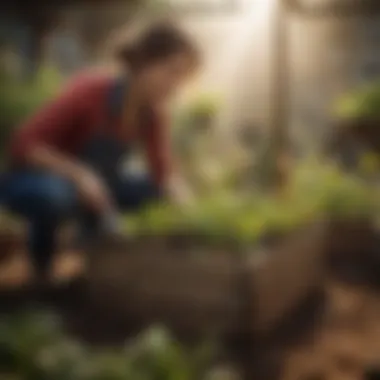
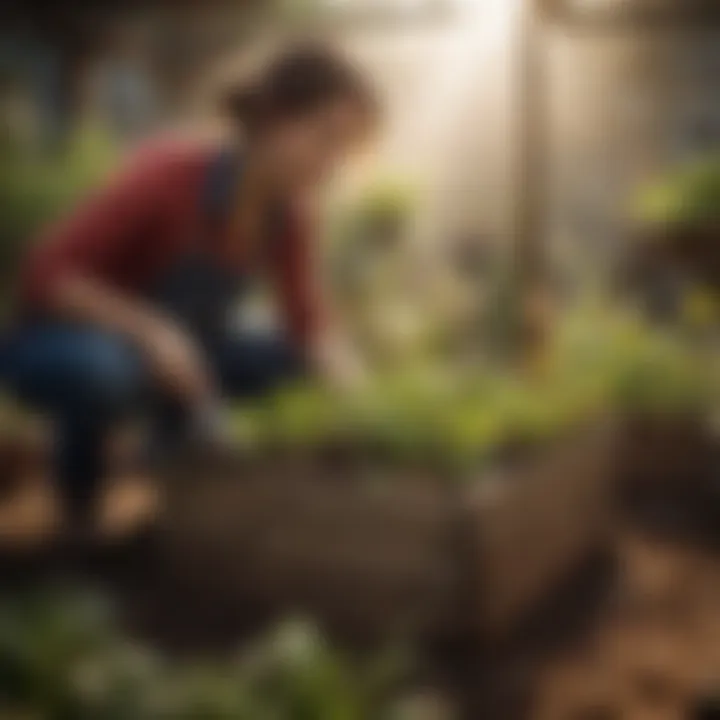
- Use a balanced fertilizer such as 10-10-10 when you initially set up the box.
- Follow up with a liquid fertilizer every couple of weeks, based on the plant type.
- Monitor nutrient levels and adjust type and amount based on plant growth and needs.
Incorporating organic fertilizers can also enhance soil health over time.
Pest Management
Controlling pests is another vital aspect of Earth Box maintenance. Regularly monitoring plants can identify potential issues before they escalate. Here are effective practices for pest management:
- Inspect plants every few days for signs of pests like aphids or spider mites.
- Use companion planting techniques, like growing marigolds alongside vegetables to deter pests.
- Employ organic pest control methods if you notice any infestations, such as insecticidal soap or neem oil.
"Regular maintenance can greatly enhance your overall gardening success. A little attention goes a long way in an Earth Box."
By implementing these maintenance practices, one can ensure that the Earth Box continues to promote a thriving growing environment. This attention not only supports the plants but also contributes to the overall effectiveness of sustainable gardening.
Plants Suitable for the Earth Box
The choice of plants for an Earth Box is crucial. Selecting appropriate plants ensures the system functions optimally, yielding healthy, vibrant results. The unique soil and water management settings in the Earth Box encourage specific types of plants to thrive. Success with this gardening method hinges on understanding the needs of various plants and their compatibility with the container's environment.
Vegetables
Vegetables are among the best choices for planting in an Earth Box. Their compact root systems and often short growing seasons make them well-suited. Popular options include tomatoes, peppers, and lettuce. These vegetables enjoy the self-watering feature since it reduces the risk of overwatering, which can lead to root rot. Additionally, their nutrient needs align well with the Earth Box’s soil management system. By using hybrid varieties, growers can maximize yield in limited space.
- Tomatoes: Require full sun and thrive with consistent watering. Their growth habit benefits from the support provided by the Earth Box frame.
- Peppers: Both sweet and hot varieties adapt well to the contained environment, requiring moderate amounts of water and nutrients.
- Lettuce: Grows quickly and can be harvested multiple times, providing fresh greens throughout the season.
Herbs
Herbs benefit greatly from the Earth Box due to their relatively low water needs and diverse growing habits. Their ability to flourish in nutrient-rich environments allows for productive spacing in urban gardening. Common herbs include basil, parsley, and cilantro. These herbs can thrive in various light conditions, making them versatile for indoor and outdoor settings.
- Basil: Prefers warm temperatures and full sunlight, making it an easy choice for Earth Box gardening.
- Parsley: Can tolerate partial shade and benefits from regular harvesting, which encourages bushier growth.
- Cilantro: Grows quickly but bolts in hot weather. Planting at staggered intervals throughout the season is advisable.
Flowers
In addition to vegetables and herbs, flowers can also be effectively grown in an Earth Box. Flowering plants contribute to aesthetics while also attracting pollinators. Options like marigolds, pansies, and petunias can thrive with proper care. They often share similar needs for sunlight and consistent moisture.
- Marigolds: Provide natural pest control and thrive under full sun, making them ideal for companion planting.
- Pansies: Known for their vibrant colors, these flowers can tolerate cooler temperatures, providing spring blooms until the summer heat.
- Petunias: Often used for their cascading growth, they need regular watering but can flourish with little maintenance.
Factors such as space, sunlight, and watering frequency must be considered when choosing plants for your Earth Box. Proper selection leads to a more successful gardening experience, whether for food production or ornamental displays.
Environmental Impact of the Earth Box
The concept of the Earth Box has a significant relevance in contemporary discussions surrounding sustainable gardening. As urban areas expand, the demand for efficient cultivation practices rises. This system not only addresses the need for effective plant growth in less space but also emphasizes ecological stewardship. The Earth Box aligns with principles of sustainability, presenting an innovative means to foster both personal and community gardening initiatives.
Sustainable Gardening Practices
Adopting sustainable gardening practices is essential in mitigating environmental degradation. The Earth Box encourages these practices in a number of ways:
- Water Efficiency: The self-watering feature minimizes water waste. This is critical in areas facing water scarcity. The Earth Box allows plants to utilize water more effectively, reducing unnecessary usage.
- Nutrient Recycling: By utilizing organic materials and compost within the Earth Box, nutrient recycling becomes easier. This helps in reducing the need for synthetic fertilizers, which can have negative effects on soil and water quality.
- Reduced Need for Pesticides: The compact, controlled environment can lead to fewer pest issues. By managing plant health more effectively, the reliance on chemical pesticides is reduced.
These elements collectively contribute to a more sustainable approach to gardening, encouraging environmentally friendly practices in urban landscapes.
Urban Agriculture Contribution
The Earth Box supports urban agriculture in several meaningful ways:
- Space Maximization: With limited land available in cities, the Earth Box allows for productive gardening in small areas, such as balconies or patios.
- Food Security: By empowering individuals to grow their own produce, the Earth Box enhances food security in urban settings, providing sustainable access to fresh food.
- Community Engagement: The use of Earth Boxes can spark community interest in gardening and agriculture. Initiatives can lead to community gardens that serve as both green spaces and educational hubs.
"Urban agriculture is not just a trend; it is an essential component of our cities’ future, ensuring sustainability and resilience."
This gardening system showcases that urban agriculture may thrive in unconventional settings, promoting a more resilient food system capable of meeting the needs of the population efficiently. With its various contributions to sustainable practices and urban settings, the Earth Box serves as a tool for positive environmental impact.
Comparative Analysis
The comparative analysis section is vital as it connects various gardening methodologies, allowing readers to grasp the strengths and weaknesses of the Earth Box in relation to other popular options. This examination provides insights on efficiency, resource utilization, and adaptability in limited spaces. It is essential for understanding how the Earth Box stands in comparison to both traditional gardening practices and hydroponics.
Earth Box vs. Traditional Gardening
The Earth Box represents a significant departure from traditional gardening techniques, which typically require extensive land and often expose plants to inconsistent watering and nutrient availability. Here are several distinguishing points:
- Water Efficiency: Traditional gardening may require frequent watering, leading to water wastage. The self-watering feature of the Earth Box retains moisture consistently, ensuring plants receive a steady water supply without excess.
- Space Utilization: Traditional gardening can necessitate large areas for cultivation. The Earth Box, being compact, allows for gardening in urban settings such as balconies or small backyards, making it a practical choice for city dwellers.
- Maintaining Soil Quality: In traditional gardens, soil can become depleted over time, requiring regular amendments. The Earth Box's design promotes optimal soil health and keeps nutrients accessible to plants.
Earth Box vs. Hydroponics
While hydroponics thrives in its ability to grow plants without soil, often yielding rapid growth rates, it also involves more complex systems and technical knowledge. The Earth Box provides a simpler entry point while offering distinct advantages:


- Ease of Use: Hydroponic systems might require users to monitor pH levels, nutrient concentrations, and more. The Earth Box uses a straightforward, soil-based approach, making it more accessible for beginners.
- Cost Considerations: Setting up hydroponic systems often incurs significant initial costs for equipment and ongoing nutrient supplies. The Earth Box comes at a lower overall investment, making it financially viable for more gardeners.
- Nutrient Absorption: Hydroponics relies heavily on artificial nutrients, whereas the Earth Box allows for organic matter to break down in soil, promoting a healthier growing environment.
The analysis highlights that the choice of gardening system should be tailored to the gardener's specific needs, available space, and personal preferences.
Challenges and Limitations
Understanding the challenges and limitations of the Earth Box gardening system is crucial for anyone looking to implement this sustainable method of growing plants. While the Earth Box offers numerous benefits, it is important to engage with the realities that come with its use. Recognizing these challenges not only helps in mitigating potential issues but also enhances the overall gardening experience. In this section, we will delve into two main areas of concern: the cost factors associated with the Earth Box and the space requirements needed for effective use.
Cost Factors
The cost of setting up an Earth Box can be a consideration for many gardeners. Initial costs include purchasing the Earth Box itself, soil, and the necessary nutrients. Depending on the quality and brand, the cost of the Earth Box can vary. Premium systems, such as the EarthBox Garden Kit, may offer extra features but come at a higher price.
However, it is important to view this expenditure through a long-term lens. The Earth Box is designed to optimize water usage and minimize waste, ultimately leading to reduced costs over time. Here are some factors that should be considered:
- Materials: The initial purchase includes sturdy materials that can last many seasons, reducing the need for frequent replacements.
- Savings on Water: Due to its self-watering design, users often find that they use less water compared to traditional gardening methods.
- Reduced Fertilizer Use: Efficient nutrient release promotes better plant health and less waste, potentially saving money on fertilizers.
Overall, while there is an upfront investment, the Earth Box can lead to considerable savings in both time and resources in the long run. It is advisable to weigh these costs against the potential benefits when deciding to adopt this gardening system.
Space Requirements
Another aspect to take into account is the spatial requirement of the Earth Box. While it is designed for compact gardening, there are still some limitations. The Earth Box structure takes up specific dimensions and may not be suitable for every garden. Thus, understanding how to effectively use space is essential.
- Location: The Earth Box should be placed in an area that receives sufficient sunlight. A sunny spot, ideally with at least six hours of direct sunlight daily, is necessary for optimal plant growth.
- Arrangement: Users must be mindful of how they arrange multiple boxes. Overcrowding can lead to competition for nutrients and light.
- Accessibility: Ensuring that there is adequate space to tend to the plants is crucial. Proper access not only aids in maintenance but also enhances the overall gardening experience.
In summary, while the Earth Box is a solution for space-efficient gardening, it is not without its limitations. Being aware of these potential challenges regarding costs and space can help users better prepare for and maximize their gardening efforts.
"By understanding both the benefits and limitations, gardeners can make informed decisions that lead to greater success in their Earth Box ventures."
Engaging with these factors thoughtfully allows for a more rewarding gardening experience.
Case Studies and Success Stories
Understanding the practical applications of the Earth Box through case studies and success stories offers significant insights into its versatility and effectiveness. Real-world experiences highlight how this gardening system has been utilized in various settings, showcasing its potential to transform urban environments and support community initiatives. By examining these narratives, one can learn not only about the techniques employed but also about the benefits and challenges faced by users.
Urban Garden Initiatives
Urban garden initiatives demonstrate how the Earth Box can effectively address space limitations and food security issues in densely populated areas. Cities often struggle with limited access to fresh produce, making initiatives using solutions like the Earth Box critical for sustainable urban living. For example, the New York City Urban Agriculture initiative capitalizes on small-scale container gardens to promote local food production. Participants use Earth Boxes to grow vegetables, herbs, and flowers, maximizing output even in minimal spaces.
These gardens not only provide food but also foster a sense of community and environmental awareness. They promote healthier eating habits by offering residents the ability to grow their own produce. Additionally, using an Earth Box facilitates a more controlled growing environment, especially in harsh urban climates where soil quality may be poor.
Some outcomes noted from these initiatives include improved community ties, increased biodiversity, and a reduction in carbon footprints due to less reliance on store-bought produce.
Community Projects
Community projects reliant on the Earth Box have shown promise in bringing together diverse groups through shared gardening experiences. For instance, programs designed for schoolyards utilize Earth Boxes as educational tools. Students gain insights into botany, ecology, and nutrition while engaging in hands-on gardening. This process not only educates children about where food comes from but also instills a sense of responsibility towards the environment.
Moreover, community gardens using Earth Boxes often serve as platforms for marginalized groups to access resources that may otherwise be unattainable. Gardens can supply fresh produce to families in food deserts, areas where access to affordable, healthy food is limited. These projects often rely on collaboration between local organizations, providing resources and support for maintenance and education.
In summary, through these case studies and success stories, it becomes apparent that the Earth Box serves as a catalyst for positive change within urban settings, enhancing food security, education, and community engagement.
"Urban gardening projects demonstrate the adaptability of the Earth Box in addressing modern agricultural challenges."
These examples illustrate that with dedication and community spirit, the Earth Box can effectively promote sustainable gardening practices and foster resilience in urban agriculture.
Future of Earth Box Gardening
The future of Earth Box gardening holds significant promise for urban agriculture and sustainable practices. As urban spaces become more populated, the need for effective and efficient gardening solutions continues to grow. Earth Box gardening represents a shift towards maximizing limited space while adhering to principles of sustainability. One of the key elements of this future is the integration of technology, which can enhance the performance of the Earth Box system.
Innovations in Container Gardening
Innovations in container gardening encapsulate new methods and technologies aimed at improving plant growth, resource management, and overall gardening efficiency. With the rise of smart gardening devices, the Earth Box can benefit from automated watering systems, integrated sensors, and mobile applications that monitor soil health and moisture levels.
The following are some notable innovations:
- Smart Sensors: These devices can detect moisture and nutrient levels, providing real-time data to the gardener. Such information allows for timely interventions, ensuring optimal plant health.
- Automated Irrigation: Systems that adjust water delivery based on plant needs can conserve water and enhance growth.
- Pre-Mixed Soil Solutions: Innovations in soil technology can lead to better nutrient absorption, which is crucial for container gardens like the Earth Box.
Implementing these innovations can result in higher yields and lower maintenance costs, making the Earth Box a more attractive option for urban gardeners.
Adapting to Climate Change
Climate change presents a multifaceted challenge to gardening practices, including temperature variations and water scarcity. The Earth Box design inherently supports resilience against such challenges. Its self-watering system conserves water while still providing plants adequate hydration, which is particularly valuable in warmer climates or during droughts.
Additional strategies for adapting Earth Box gardening to climate change include:
- Use of Climate-Resilient Crops: Selecting plants that are genetically engineered to withstand extreme weather can significantly contribute to sustainability.
- Soil Management Practices: Utilizing organic soil amendments can improve soil structure and increase its ability to hold moisture, thus supporting plants during dry periods.
The importance of adapting gardening systems to fall in line with environmental changes cannot be overstated. This adaptability encourages sustainable practices and directly contributes to food security in urban settings.
"The ability to adapt and adopt new gardening technologies not only prepares us for future hardships but also maximizes our resources effectively."



